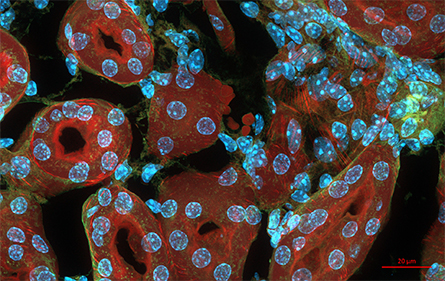From the journals: JBC
A novel player involved in kidney injury response. The role of the Kaposi’s sarcoma-associated herpes virus in kinase pathway activation. Understanding what a linker does in heme extraction. Read about these papers recently published in the Journal of Biological Chemistry.
Novel player involved in kidney injury response
Fibrosis involves the excessive accumulation of extracellular matrix, which may result in loss of function when normal tissue is replaced by scar tissue, such as after injury. In the case of kidney disease in particular, fibrosis is the final step in chronic disease characterized by the accumulation of interstitial fibroblasts and myofibroblasts in addition to ECM accumulation.

Follistatin-like 1 is a secreted protein. While the role FSTL1 plays in heart and lung injury and development of fibrosis have been studied widely, the role this protein plays in kidney injury and progression to chronic disease remains to be determined.
In a recent article in the Journal of Biological Chemistry, Yu Zhang and colleagues from the School of Biomedical Sciences at the Chinese University of Hong Kong and the Center of Nephrology and Urology at Sun Yat-sen University in China report that FSTL1 plays a profibrotic role in the kidney.
The team used several molecular biology and imaging techniques — including single-cell RNA-Seq analysis and immunofluorescence — to show that Fstl1 was enriched in stromal cells in obstructed mouse kidneys and that FSTL1 expression was induced in fibroblasts during kidney fibrogenesis in mice and in human patients.
In addition, the authors showed FSTL1 overexpression increased renal fibrosis and activated the Wnt/beta-catenin signaling pathway, whereas inhibition of FSTL1 lowered Wnt/β-catenin signaling.
A virus oncoprotein’s role in kinase pathway activation
The Kaposi’s sarcoma-associated herpes virus is the main etiological agent of Kaposi’s sarcoma, which manifests as patchy cancerous tumors on the skin and mucus membranes. It most often affects people with immune deficiencies, such as those with HIV/AIDS.
The virus — known as KSHV and human herpesvirus 8 — belongs to the same family as Epstein–Barr virus, which is responsible for causing infectious mononucleosis and several cancer types and recently has been implicated in the development of multiple sclerosis.
The virally coded oncoprotein vFLIP is known to upregulate the inhibitor of kappa B kinase, or IKK, complex, activating the canonical nuclear factor κB signaling pathway, a major factor in KSHV pathogenesis.
The physical interaction of vFLIP and the IKK kinase regulatory component, IKK gamma, is essential for persistent activation and has been studied widely; however, how the kinase subunits are active mechanistically remains to be determined.
In a recent Journal of Biological Chemistry article, Claire Bagnéris, Swathi L. Senthil Kumar and collaborators at the Institute of Structural Molecular Biology in London report that vFLIP alone is sufficient to activate the IKK kinase complex. The researchers used a combination of cell-based assays and biophysical and structural biology techniques.
The authors also found weakly stabilized, high-molecular-weight vFLIP-IKKγ assemblies relevant to the activation process.
In the end, this novel study determined that vFLIP-induced NF-κB activation relies upon structurally specific vFLIP–IKKγ multimers that are essential to activate kinase subunits by autophosphorylation.
The proof is in the linker
Iron acts as an electron carrier and a co-factor in many proteins; this makes it an essential nutrient for living organisms, including pathogenic bacteria such as Staphylococcus aureus, which is responsible for deadly nosocomial infections.
The iron-regulated surface determinant system is a family of proteins that sequesters iron from the host to support bacterial growth and is therefore a potential therapeutic target. The surface protein IsdH consists of three near-iron transporter, or NEAT, domains connected by linkers, and it is responsible for capturing hemoglobin.
In a recent Journal of Biological Chemistry article, Sandra Valenciano–Bellido and colleagues at the University of Tokyo characterized the linker region between the NEAT2 and NEAT3 domains using multiple biophysical techniques to understand better the role it plays in heme extraction.
The researchers showed that the linker region contributes to the stability of the bound protein and this, in turn, influences the flexibility and orientation of the NEAT3 domain in its interaction with hemoglobin.
The authors suggest this model explains how the linker region facilitates NEAT3 positioning to sequester heme, and they argue that the study adds to researchers’ understanding of the mechanism of heme extraction of human hemoglobin by IsdH.
Enjoy reading ASBMB Today?
Become a member to receive the print edition four times a year and the digital edition monthly.
Learn moreGet the latest from ASBMB Today
Enter your email address, and we’ll send you a weekly email with recent articles, interviews and more.
Latest in Science
Science highlights or most popular articles

Bacteriophage protein could make queso fresco safer
Researchers characterized the structure and function of PlyP100, a bacteriophage protein that shows promise as a food-safe antimicrobial for preventing Listeria monocytogenes growth in fresh cheeses.

Building the blueprint to block HIV
Wesley Sundquist will present his work on the HIV capsid and revolutionary drug, Lenacapavir, at the ASBMB Annual Meeting, March 7–10, in Maryland.

Gut microbes hijack cancer pathway in high-fat diets
Researchers at the Feinstein Institutes for Medical Research found that a high-fat diet increases ammonia-producing bacteria in the gut microbiome of mice, which in turn disrupts TGF-β signaling and promotes colorectal cancer.

Mapping fentanyl’s cellular footprint
Using a new imaging method, researchers at State University of New York at Buffalo traced fentanyl’s effects inside brain immune cells, revealing how the drug alters lipid droplets, pointing to new paths for addiction diagnostics.

Designing life’s building blocks with AI
Tanja Kortemme, a professor at the University of California, San Francisco, will discuss her research using computational biology to engineer proteins at the 2026 ASBMB Annual Meeting.

Cholesterol as a novel biomarker for Fragile X syndrome
Researchers in Quebec identified lower levels of a brain cholesterol metabolite, 24-hydroxycholesterol, in patients with fragile X syndrome, a finding that could provide a simple blood-based biomarker for understanding and managing the condition.

